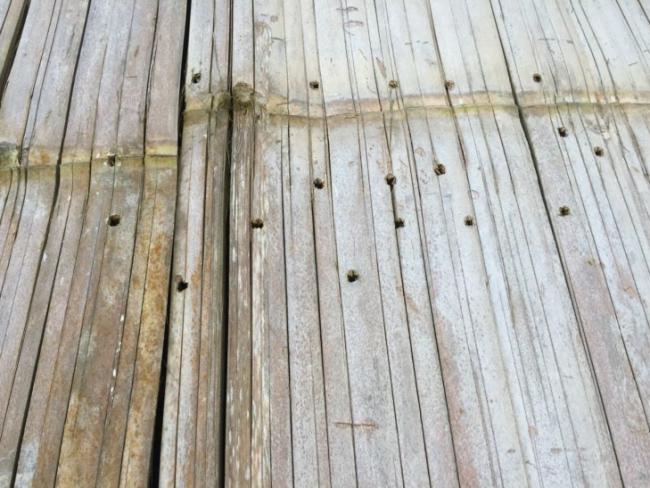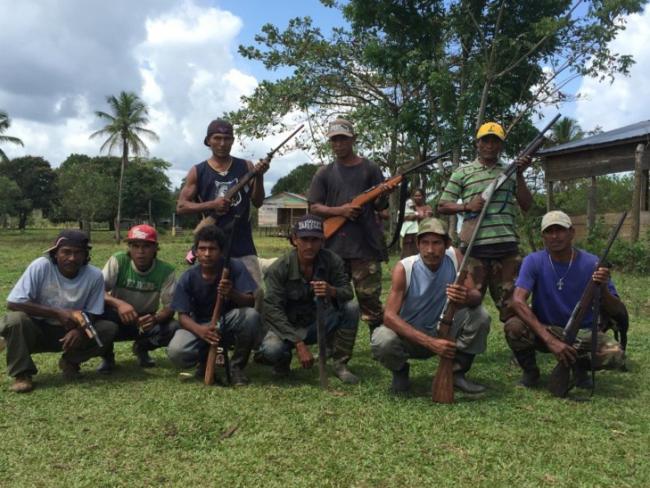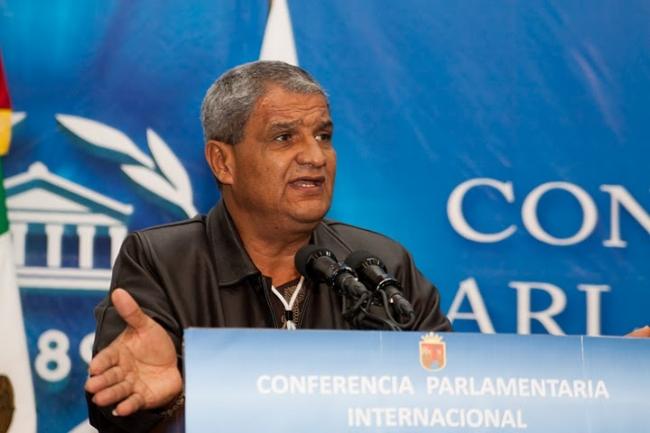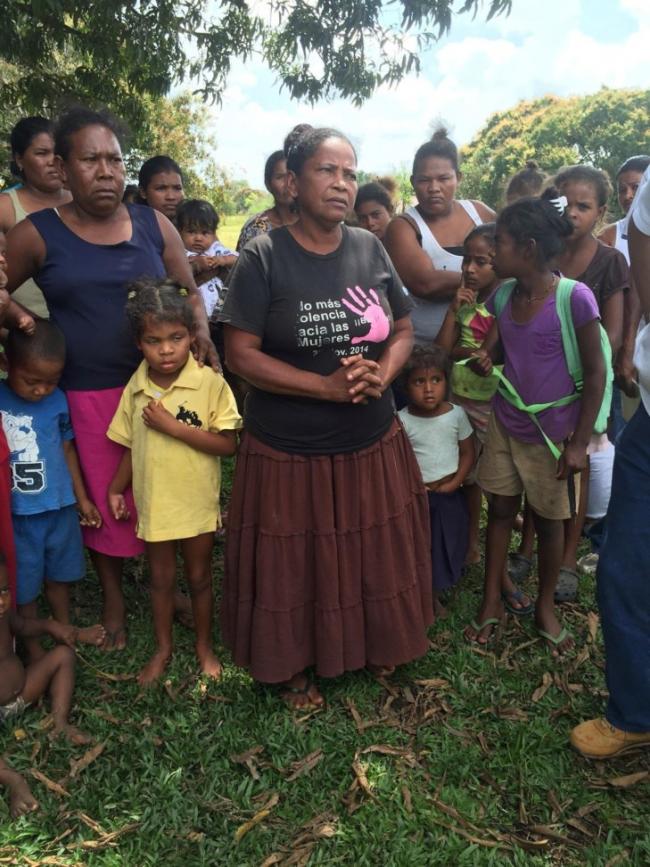
The Miskitu—an indigenous group of around 180,000 people who inhabit the Muskitia, a rainforest that expands from Black River, Honduras to Bluefields, Nicaragua—are perhaps most famous for the role they played as a counterrevolutionary force against the Sandinista (FSLN) revolution in the U.S.-backed Contra War of the 1980s. Despite the Miskitu’s allegiance to the Contras, in 1987, the FSLN state passed a law to appease the Miskitu’s demands. Under the terms of Nicaragua’s so-called “autonomy law” (Law 28), two pluriethnic, autonomous regions were established on the country’s Caribbean coast, a region that is home not only to the Miskitu but also the indigenous Sumu-Mayangna and Rama people, the Afro-descendant ‘Kriols, and the Afro-indigenous Garífuna, among others. What’s more, Law 28 awarded indigenous and Afro-descendant peoples the right to the preservation of their cultures and languages, self-governance, and resource control and declared that communal lands were inalienable, meaning they “could not be donated, sold, leased or taxed.’ At the time, the Law 28 represented one of the most novel and progressive advances in state-indigenous relations anywhere in Central America.
Since the passage of Law 28, a series of international and national laws and declarations have, at least in name, supported indigenous peoples’ ongoing quest for autonomy in the Nicaraguan Caribbean. In 2003, for example, Nicaragua adopted a new communal property law (Law 445), which provided community-elected, indigenous authorities a leadership role in the process of demarcating and gaining legal title to their communal lands—something Law 28 had stopped short of doing. Moreover, Law 445 gave the Nicaraguan state the power to carry out saneamiento (cleansing), a term that refers to the forced removal of colonos (settlers) and extractive industries from indigenous and Afro-descendant territories.
Despite these legal protections granted to the Miskitu, the reality on the ground has been far from peaceful in recent years, as the coastal peoples of Nicaragua are once again fighting for their survival in the face of violence and on-going land grabs. Although the current government publicly agreed to saneamiento, to date it has not responded with any plan of action or to requests for comment about the policy. Moreover, since 2013 mestizo colonists have killed 30, wounded 38, and kidnapped 18 Miskitu men with almost complete impunity. The colonists’ periodic attacks on Miskitu communities continue unabated in Wangki Twi-Tasba Raya, Li Aubra, and now, Lilamni Tasbaya Kum.
As a result, some 3,000 Miskitu people— mainly women, children, and the elderly— have become internally-displaced refugees, forced to flee to Waspam, Puerto Cabezas-Bilwi, and Honduran border communities, such as Sují. The refugees lack basic medical supplies. Many children have not attended school for over eight months. Today, colono settlers are believed to be illegally occupying nearly half of the indigenous and Afro-descendant ancestral territories of the Caribbean.
How has all of this come to pass in Nicaragua, a country that was not so long ago considered to be one the most progressive countries in the region when it came to the rights of its indigenous peoples?
Starting in the early 1990s, Spanish-speaking mestizo colonos from the interior and Pacific coast began invading Nicaragua’s Caribbean coast —often at the behest of the country’s lauded cattle-ranching class and with the tacit support of the Nicaraguan state.
Colono land grabs in the Muskitia rainforest land increased significantly starting around 2008, a year after Daniel Ortega and the FSLN returned to power. The driving forces behind this migration were a drought on the Pacific coast as well as the expansion of extractive industries throughout much of Nicaragua’s rural interior. These conditions forced Nicaraguan farmers who typically grew corn, yucca, rice, and beans, but who could no longer support their families on dry soils, to search for more fertile lands on the Caribbean coast. The general decline of the agricultural industry in Nicaragua— the share of Nicaragua’s GDP this is based on agricultural business fell from 40 percent in the 1970s to 17.5 percent in 2014—also added to the farmer’s difficulty in earning a living.
Amidst the decline in the agricultural industry, large, land-owning cattle ranchers have consolidated their own land holdings in the country. In some cases these ranchers pay the colonos to settle indigenous lands in order to eventually control the land for themselves. Nicaraguan cattle ranchers also supply settlers with weapons, and many have flipped large swaths of land, selling property to large agro-industrial businesses, and at times even narco-traffickers. This situation has increased the militarization of Nicaragua’s countryside and precipitated the building of new army bases in the region, and transformed many colonos into a quasi-paramilitary force for Nicaragua’s landholding elite. (A similar situation involving narco-trafficking and deforestation has also unfolded in the Hondruan Muskitia.)
For the most part, the Nicaraguan government has tacitly supported the passage of fraudulent land titles and dispossession by the colonos through its promotion of extractive industries and mega-projects in Muskitia. The FSLN government has approved mining and forestry concessions to companies such as HEMCO mining, a Colombian company, and ALBA Forestal, a logging company that operates under the protection of the state institution MARENA (Ministerio del Ambiente y Los Recursos Naturales). ALBA Forestal, launched in 2009, is a joint Nicaraguan-Venezuelan company controlled by President Daniel Ortega and the FSLN. As such, the company operates with little transparency and has contributed to the rapid deforestation of the Mayangna Bosawas Biosphere Reserve, an area that is considered to be the “lungs” of Central America.
Corrupt officials in the autonomous regions of the Miskitu coast have also been implicated in the illegal selling or trafficking of indigenous lands for personal profit— which direct affronts the country’s communal property law (Law 445). Many colonos have entered the Las Minas area of the Miskitu region and unknowingly purchased fraudulent land titles from corrupt officials; the colonos then pay lawyers and notaries for their legal services and fabricated documents. With these fraudulent titles in hand, settlers then enter Miskitu Wangki Twi-Tasba Raya and the Mayangna Amasau territories through a road built by international banana plantation owners before the revolution.
Despite the fact that the settlers’ colonization of indigenous lands clearly violates national and international laws, the Nicaraguan government has behaved indifferently to the crisis and failed to provide protection to those Miskitu communities whose livelihoods have been under attack. As a result, many Miskitu people suspect the Sandinista state has been complicit in the colonists’ invasion of their indigenous territories.
Brooklyn Rivera was an anti-FSLN military leader during the Contra war of the 1980s who has served as the Líder Máximo (Highest Leader) of the Nicaraguan Miskitu people for over 30 years. Rivera spoke about the issue at the 2016 UN Permanent Forum on Indigenous Issues in May: “The government imposes violence against our communities by means of settlers who invade ancestral territories, carrying out armed attacks, murders, kidnappings, rape, and displacement, producing refugees, most of whom are women, children, and people of old age,” he stated. “All this occurs in the face of governmental and institutional passivity, even complicity.”
In response, the Nicaraguan state and the army argue that dialogue, co-habitation, and working together can solve the crisis between the colonists and indigenous peoples. Similarly, Ortega denounces the illegal trafficking of lands by officials in the autonomous regions as the main impetus of the colonial invasion, blaming the regional leaders themselves. However, Ortega may be motivated to support the colonos because the FSLN is counting on its votes to win the general elections against the Yatama indigenous party—including the election of deputies to the National Assembly— this year. Additionally, Ortega (FSLN) surely does not want to eradicate ALBA Forestal from Muskitia, nor pay thousands of colonists to leave their lands and, in turn, provide them alternative lands to re-settle.
Do rising tensions between the Miskitu people and the Sandinistas represent a return to the conflicts that fueled the struggles of the 1980s—a period when a U.S.-backed anti-communist crusade blended with an ethnic conflict that pitted indigenous peoples against the country’s mestizo majority? Although the Cold War is over, many Miskitu suggest the ethnic tensions of the 1980s persist. In Wangki Twi–Tasba Raya, groups of young Miskitu men patrol their forests and stand guard over their nearly vacated communities.

The men who patrol the town of Francia Sirpi recently wrote a song, now played by local radio stations, whose lyrics evoke the connections that tie the violence of the past to the region’s present:
“Ancestral Miskitu warriors/ where are you now? During the 1980s/ a war broke out after/ a conflict occurred/ the big War had arrived/ In Francia Sirpi in the year 2015/ violence is erupting again/ and a bigger conflict may follow. In Francia Sirpi, there were Miskitu teen-age boy warriors/ crawling military style on the ground/ when all of the sudden/ the mestizo colonos began to shoot…/Miskitu Contra warriors/ where are you now?” (Translated from the Miskitu language)
The song’s refrain raises a particularly eerie allusion to the violence of the 1980s: “Comandante nani anira sma?/Miskitu Contra warriors, where are you now?”
The past reverberates not only in contemporary Miskitu culture, but also in in the current leadership of both the governing FSLN and the Miskitu. Both Brooklyn Rivera and current Nicaraguan President Daniel Ortega (FSLN) served as heads of their respective groups during the FSLN revolution and Contra War of the 1980s. In 1987, Rivera founded and became the long-term director of the Yatama (Yapti Tasba Masraka Nanih Aslatakanka/Sons of Mother Earth) indigenous organization, and ersatz political party. Ortega, who was Nicaragua’s president from 1985-1990, was elected to power again in 2007. He is expected to be reelected to controversial third, consecutive term in November of this year.
In 2006, an alliance between Rivera and the FSLN, known as the Yatama-FSLN alliance, briefly calmed the waters between longtime foes. During that period, Rivera served as a deputy in the country’s National Assembly and as Nicaragua’s President of Asuntos de los Pueblos Indígenas, Afrodescendientes y Regímenes Autonómicos (Matters of Indigenous People, Afro-Descendants and Autonomous Regiments). But in March 2014, the FSLN-Miskitu pact fell apart. Although Rivera remained in office, he refocused his efforts on the saneamiento movement that has sought to remove colonos and cattle-ranchers from indigenous lands. Tension mounted when Yatama leaders tried to cancel Independence Day celebrations in Waspam because of recent attacks committed against Miskitu communities in nearby Wangki-Twi Tasba Raya. After Yatama members through stones at Independence Day parade participants on September 14, Sandinista youth shot one Miskitu leader, who eventually died of a heart attack. On the early morning of September 15, the military and police shot several Miskitu leaders, seriously injuring two leaders while taking needed food supplies to Santa Clara, a Miskitu community in the Wangki-Twi Tasba Raya territory affected by the recent violence.
In the following week, the FSLN-controlled National Assembly unconstitutionally removed Rivera from office. In one hour (and without prior notice), Rivera was accused, tried, and found guilty of selling Indian lands. He was subsequently removed from office and stripped of his diplomatic immunity. “My ouster was televised on the national news to publicly humiliate me and create a distraction from the FSLN government’s own culpability and involvement in the much larger invasion and confiscation of indigenous lands,” Rivera told me in an interview in March 2015.

Meanwhile, many Miskitu activists say that if the government continues to allow their ancestral lands to be colonized and invaded, they will take matters into their own hands to remove the colonos through auto-saneamiento—that is, “self-cleansing” of the indigenous territories. On August 30, 2016, after the two corpses of kidnapped Miskitu men were found dismantled and decapitated, an organized force of 200 armed Miskitu threatened to attack and dislodge colonists from their lands. Rivera now says indigenous people of the coast are organizing to “defend our rights, to defend our territory, [and] prevent the settlers from continuing to invade our lands.”
Unfortunately for the Miskitu, Ortega and the FSLN passed a new law in December 2015, known as Seguridad Soberana (Sovereign Security, SS) (Law 919), which gives the Nicaraguan army and police the power to determine who constitutes an “enemy of the state” and why. The FSLN is expected to primarily use the SS law during the 2016 electoral year to criminalize protests against the Ortega dictatorship and its proposed Chinese-backed, interoceanic canal (see below), however the FSLN could also use the SS law to criminalize the Miskitu sanamiento forces. Increasingly, the situation looks like a powder keg waiting to explode—a Miskitu attack on the mestizo settlers could spark a larger conflict with the Nicaraguan army.

Added to this volatile situation are the widely reported plans of the Nicaraguan government to commence construction of the Nicaraguan Canal. The canal will traverse Lake Nicaragua, the largest fresh-water lake in Central America, wreaking unprecedented environmental havoc in the greater region, and it would threaten the livelihoods of many indigenous and Afro-descendant people. As Jennifer Goett wrote recently for NACLA, the canal’s point of entry is set to cut through the ancestral homeland of the indigenous Rama and Afro-descendant ‘Kriol’ peoples in the southern autonomous region.
The Miskitu men and women I spoke with in Puerto Cabezas-Bilwi and the Waspam region in the summers of 2015 and 2016 strongly opposed the canal. They told me they feared the canal would irreparably damage the Muskitia ecosystem and lead to the destruction of their cultures and peoples. Indigenous leaders and human rights organizations in Nicaragua, such as the Center for Legal Assistance for Indigenous Peoples (Calpi), and the Centro por la Justicia y Derechos Humanos de la Costa Atlantica de Nicaragua also point out that the Nicaraguan state has failed to meet the minimum standard of free, prior, and informed consent concerning the canal mega-project.
Though there is some question about whether or not the canal will ever be completed, many suspect that the Nicaraguan government plans to use the canal as an excuse to accumulate FSLN state land holdings by their taking control of all lands along the proposed canal route currently owned by individual farmers, thereby expropriating their lands. Presently, the government has plans to relocate between 30,000 and 120,000 people, mainly mestizo farming families living along the canal route. And following the path blazed by the colonos, many of those who will be displaced are likely to move to the Caribbean Coast, the new final frontier of Nicaraguan colonization.
Laura Hobson Herlihy received her doctorate in anthropology from the University of Kansas in 2002 and has since worked as a lecturer in the KU Center of Latin American and Caribbean Studies. Herlihy has completed research among the Honduran and Nicaraguan Miskitu for over twenty years and since 2011, has directed a U.S. Department Of Education IRIS-approved, summer Miskitu language program in Puerto Cabezas-Bilwi.

